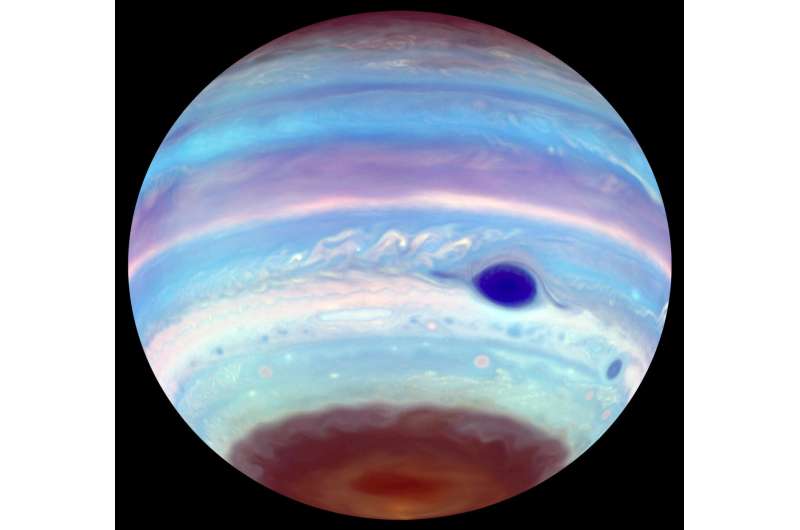
While Jupiter’s Great Red Spot has been a constant feature of the planet for centuries, University of California, Berkeley, astronomers have discovered equally large spots at the planet’s north and south poles that appear and disappear seemingly at random.
The Earth-size ovals, which are visible only at ultraviolet wavelengths, are embedded in layers of stratospheric haze that cap the planet’s poles. The dark ovals, when seen, are almost always located just below the bright auroral zones at each pole, which are akin to Earth’s northern and southern lights.
The spots absorb more UV than the surrounding area, making them appear dark on images from NASA’s Hubble Space Telescope. In yearly images of the planet taken by Hubble between 2015 and 2022, a dark UV oval appears 75% of the time at the south pole, while dark ovals appear in only one of eight images taken of the north pole.
The dark UV ovals hint at unusual processes taking place in Jupiter’s strong magnetic field that propagate down to the poles and deep into the atmosphere, far deeper than the magnetic processes that produce the auroras on Earth.
The UC Berkeley researchers and their colleagues report the phenomena Nov. 26 in the journal Nature Astronomy.
Dark UV ovals were first detected by Hubble in the late 1990s at the north and south poles and subsequently at the north pole by the Cassini spacecraft that flew by Jupiter in 2000, but they drew little attention.
When UC Berkeley undergraduate Troy Tsubota conducted a systematic study of recent images obtained by Hubble, however, he found they were a common feature at the south pole—he counted eight southern UV-dark ovals (SUDO) between 1994 and 2022.
In all 25 of Hubble’s global maps that show Jupiter’s north pole, Tsubota and senior author Michael Wong, an associate research astronomer based at UC Berkeley’s Space Sciences Laboratory, found only two northern UV-dark ovals (NUDO).
Most of the Hubble images had been captured as part of the Outer Planet Atmospheres Legacy (OPAL) project directed by Amy Simon, a planetary scientist at the NASA Goddard Space Flight Center and a co-author of the paper. Using Hubble, OPAL astronomers make yearly observations of Jupiter, Saturn, Uranus and Neptune to understand their atmospheric dynamics and evolution over time.
“In the first two months, we realized these OPAL images were like a gold mine, in some sense, and I very quickly was able to construct this analysis pipeline and send all the images through to see what we get,” said Tsubota, who is in his senior year at UC Berkeley as a triple major in physics, mathematics and computer science.
“That’s when we realized we could actually do some good science and real data analysis and start talking with collaborators about why these show up.”
Wong and Tsubota consulted two experts on planetary atmospheres—Tom Stallard at Northumbria University in Newcastle-upon-Tyne in the UK and Xi Zhang at UC Santa Cruz—to determine what could cause these areas of dense haze.
Stallard theorized that the dark oval is likely stirred from above by a vortex created when the planet’s magnetic field lines experience friction in two very distant locations: in the ionosphere, where Stallard and other astronomers previously detected spinning motion using ground-based telescopes, and in the sheet of hot, ionized plasma around the planet shed by the volcanic moon Io.
Discover the latest in science, tech, and space with over 100,000 subscribers who rely on Phys.org for daily insights.
Sign up for our free newsletter and get updates on breakthroughs,
innovations, and research that matter—daily or weekly.
The vortex spins fastest in the ionosphere, progressively weakening as it reaches each deeper layer. Like a tornado touching down on dusty ground, the deepest extent of the vortex stirs up the hazy atmosphere to create the dense spots Wong and Tsubota observed. It’s not clear if the mixing dredges up more haze from below or generates additional haze.
Based on the observations, the team suspects that the ovals form over the course of about a month and dissipate in a couple of weeks.
“The haze in the dark ovals is 50 times thicker than the typical concentration,” said Zhang, “which suggests it likely forms due to swirling vortex dynamics rather than chemical reactions triggered by high-energy particles from the upper atmosphere. Our observations showed that the timing and location of these energetic particles do not correlate with the appearance of the dark ovals.”
The findings are what the OPAL project was designed to discover: how atmospheric dynamics in the solar system’s giant planets differ from what we know on Earth.
“Studying connections between different atmospheric layers is very important for all planets, whether it’s an exoplanet, Jupiter or Earth,” Wong said.
“We see evidence for a process connecting everything in the entire Jupiter system, from the interior dynamo to the satellites and their plasma torii to the ionosphere to the stratospheric hazes. Finding these examples helps us to understand the planet as a whole.”
More information:
Troy K. Tsubota et al, UV-dark polar ovals on Jupiter as tracers of magnetosphere–atmosphere connections, Nature Astronomy (2024). DOI: 10.1038/s41550-024-02419-0
Journal information:
Nature Astronomy
Provided by
University of California – Berkeley
Magnetically driven vortices may be generating Earth-size concentrations of hydrocarbon haze at Jupiter’s poles (2024, November 26)
retrieved 26 November 2024
from https://phys.org/news/2024-11-magnetically-driven-vortices-generating-earth.html
part may be reproduced without the written permission. The content is provided for information purposes only.